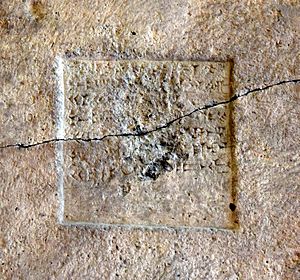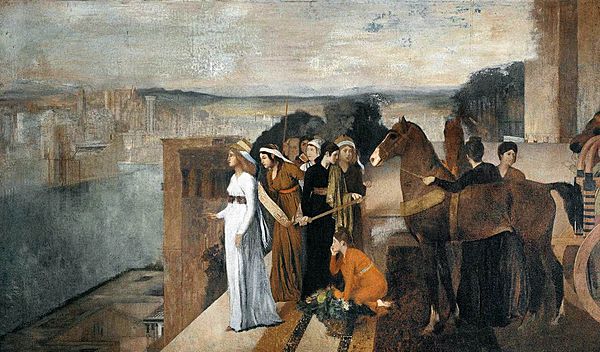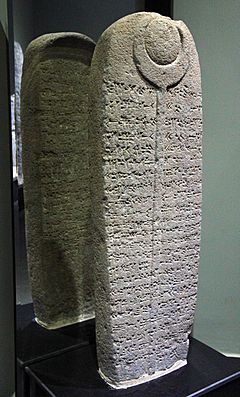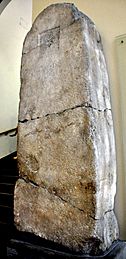Shammuramat facts for kids
Quick facts for kids Shammuramat |
|
|---|---|
| Woman of the Palace | |

|
|
| Born | c. 850 BC |
| Died | c. 798 BC (aged c. 52) |
| Spouse | Shamshi-Adad V |
| Issue | Adad-nirari III |
| Akkadian | Sammu-rāmat or Sammu-ramāt |
Shammuramat was a very powerful queen of the Neo-Assyrian Empire. She is also known by names like Sammuramat, Shamiram, and Semiramis. She started as the main wife of King Shamshi-Adad V (who ruled from 824–811 BC).
Shammuramat became even more important when her son, Adad-nirari III, became king (ruling from 811–783 BC). She was one of the most influential women in the ancient Near East. She is the only known Assyrian queen who kept her queenly status after her husband died. She is also the only ancient Assyrian or Mesopotamian woman known to have joined, and perhaps even led, a military campaign.
We don't know exactly where Shammuramat came from. Her name could be from West Semitic or Akkadian languages. She might have been from Assyria, Babylonia, the Levant, or Phoenicia. If she was a foreigner, people often think she was a princess. We don't know much about her influence when her husband was king.
However, under her son Adad-nirari, her role was very special for a woman of that time. A stone carving called the Pazarcık Stele shows she went with her son on a military trip against the Hittites in Kummuh. Both she and Adad-nirari are given credit for making the empire bigger. In some writings, local governors honored both the king and Shammuramat, which was very unusual. All signs show that Shammuramat was a very famous person in her time.
Later stories in Persian, Levantine, and Greek cultures remembered Shammuramat as the legendary warrior-queen Semiramis. This Semiramis was said to be a half-goddess and the wife of a fictional king named Ninus. Ninus was the mythical founder of Nineveh and the Assyrian Empire. Legendary deeds of Semiramis include winning a battle at the city of Bactra and founding Babylon. She was also said to have invented a type of pants. Both Shammuramat and Semiramis are still popular names for girls among the Assyrian people today.
Contents
Understanding Shammuramat's Name
Shammuramat's name was written as Sammu-rāmat or Sammu-ramāt in ancient Assyrian writings. It might come from either West Semitic or East Semitic Akkadian languages.
One idea is that her name means "Sammu is exalted" or "Sammu is beloved." Sammu was a lesser-known god during the Neo-Assyrian period.
In ancient Greek writings, her name appeared as Semiramis. Some ancient historians thought the name came from the Akkadian word for "dove." Another idea from a Jewish text suggests it means "thunder of heaven." In 1991, a scholar named Moshe Weinfeld thought it might mean "high heavens" in Phoenician.
Where Did Shammuramat Come From?
Shammuramat was born around 850 BC. Ancient records don't say much about her background. Later Greek and Roman stories sometimes said she was from the Levant or was a native Assyrian.
Modern historians have guessed other places she might have come from. Some thought she was a princess from Babylonia or even Urartu. One idea was that she was a princess from Ashkelon, but this seems unlikely because that city was not very important to Assyria at the time. Another idea is that she was an Assyrian or Aramean princess from Syria.
Shammuramat's Role and Power
During King Shamshi-Adad V's Rule
Shammuramat was the wife and queen of the Assyrian king Shamshi-Adad V (824–811 BC). We don't have many records about her from this time. She is only mentioned on one special bead. This bead says:
To Ishtar, her lady, Shammuramat, queen of Shamshi-Adad, king of Assyria, dedicated (this) for her well-being.
This shows she was devoted to the goddess Ishtar. We don't know how much power she had during her husband's reign.
During King Adad-nirari III's Rule
Shammuramat became much more important when her son, Adad-nirari III, became king (811–783 BC). Adad-nirari was likely young when he became king. This might be why his mother was able to take on such a big role. Her exact power is still debated by historians, but it's clear she was a very famous person.
Some historians think Shammuramat might have been a "queen regnant," meaning she ruled the empire herself for a time. This is because she kept using the title "queen" even after her husband died. This was very unusual for an Assyrian queen. Other queens might have been called "Mother of the King," but not "queen."
Historians like Sarah C. Melville have suggested she might have acted as a regent. A regent is someone who rules for a young king until he is old enough. Even if she wasn't officially a co-ruler, Shammuramat was clearly a powerful woman. She played a big part in running the empire, especially when her son was young.
The strongest sign of Shammuramat's great power is a special stone marker called a boundary stone. This stone was set up by Adad-nirari near modern-day Pazarcık in Turkey. Assyrian royal writings usually followed strict rules. Any changes to these rules were very important.
The Pazarcık Stele shows that Shammuramat went with her son on a military trip against the Kingdom of Kummuh in Syria. She is the only known ancient Assyrian woman to have taken part in a military campaign. Some scholars even think she might have led the campaign herself.
The stone carving says that Adad-nirari did the fighting. This was important for Assyrian beliefs about kings. But, the important act of expanding Assyrian land and setting up the stone is credited to both Adad-nirari and Shammuramat. The text uses a plural word, "they," for this. Also, the stele mentions Adad-nirari's family line through both his father and his mother. Kings usually only mentioned their father's side.
The full writing on the boundary stone says:
Boundary stone of Adad-nirari, king of Assyria, son of Shamshi-Adad, king of Assyria (and of) Shammuramat, queen of Shamshi-Adad, king of Assyria, mother of Adad-nirari, mighty king, king of Assyria, daughter-in-law of Shalmaneser, king of the Four Corners. When Ušpilulume, king of Kummuh, caused Adad-nirari, king of Assyria (and) Shammuramat, queen, to cross the Euphrates river; I smashed Attar-šumkī, son of Abī-rāmi, of the city Arpad, together with eight kings, who were with him at the city Paqarḫubunu, their boundary and land. I deprived them of their camp. In order to save their lives, they went up (the mountains). In that year they put up this boundary stone between Ušpilulume, king of Kummuh and Qalparuda, son of Palalam, king of Gurgum. Whoever takes it away from the possession of Ušpilulume, his sons, his grandsons, may the gods Ashur, Marduk, Adad, Sîn, (and) Shamash not support his lawsuit. Prohibition of Ashur, my god, (and) Sîn, who dwells in Harran.
Shammuramat was famous even during her lifetime. In Assur, the religious center of the Assyrian Empire, many stone markers (steles) were set up by kings and important male officials. But only three were set up by women. Shammuramat's stele was one of them. This shows she was a truly exceptional woman. Her stele in Assur gives her the same important titles as the Pazarcık boundary stele.
Shammuramat is also mentioned on two statues from Kalhu, the Assyrian capital. These statues were dedicated to the god Nabu by the governor of Kalhu. The writings on the statues say they were made "for the life of" both King Adad-nirari and Queen Shammuramat. Usually, only the king was mentioned in such dedications.
Some older translations of a stone called the Saba'a Stele suggested that Shammuramat ruled the empire for five years after her husband died. However, newer translations of the text show that this was likely not the case.
It's possible that Shammuramat later became a temple woman. This might have happened at the Nabu temple in Kalhu, where statues were dedicated to her. Shammuramat likely died around 798 BC.
The Legend of Semiramis

Historians have long believed that Shammuramat was the main inspiration for the legendary Assyrian warrior-queen and hero, Semiramis. However, the Semiramis legend probably also includes ideas from other real and mythical figures from the ancient Near East.
No ancient Assyrian writings about the Semiramis legend have been found yet. But it is thought to have started as an Assyrian story. Later, it spread to Persian and then Greek and Roman writings. We mostly know the legend today from the writings of Diodorus Siculus and Ctesias.
According to Ctesias, Semiramis was born in Ashkelon. Her mother was the goddess Derceto, and her father was a human. Derceto was said to have abandoned her baby daughter and turned into a mermaid-like creature. Doves supposedly kept the baby Semiramis alive by keeping her warm and feeding her. Later, a shepherd found and adopted her.
The legend connects Semiramis to Ashkelon and a special respect for fish. In ancient Mesopotamia, the god Nabu was sometimes linked to fish. Since statues were dedicated to Shammuramat at a Nabu temple, there might be a small connection.
In most legends, Semiramis marries Ninus, a legendary founder of Nineveh and the Assyrian Empire. Ninus is usually overshadowed by his wife in these stories. Ctesias said that Semiramis and Ninus founded the Assyrian Empire around 2166 BC.
In Ctesias's story, young Semiramis first married an Assyrian general named Onnes. Onnes was fighting with Ninus to capture the city of Bactra. When the battle was taking a long time, Onnes sent for his wife. Semiramis thought he needed military help. So, she dressed for war, hiding that she was a woman. She even invented long-sleeved pants that hid the wearer's gender. These pants were later popular among the Medes and Persians.
When Semiramis arrived in Bactra, she proved to be a skilled warrior. She helped capture the city, which made Ninus admire her greatly. Ninus then wanted Semiramis for himself. When Onnes refused to give up his wife, Ninus threatened him, and Onnes took his own life. After this, Semiramis became Ninus's wife.
In the stories by Ctesias and Diodorus Siculus, Ninus was old when he married Semiramis. He died soon after their son, Ninyas, was born. Ninus's death left Semiramis to rule the empire. She built a huge mound over Ninus's grave. She also built other mounds for generals, officials, and former lovers. To compete with Nineveh, which her husband founded, Semiramis is credited with founding Babylon. Ctesias even says Semiramis created the Hanging Gardens of Babylon. However, there is no real evidence connecting Shammuramat to Babylon or any building projects there.
The legendary Semiramis also led military campaigns. She fought against Armenia and India. The story of her conflict with Armenia might come from memories of Adad-nirari's campaigns against Urartu, which was a kingdom that came before Armenia. One of Adad-nirari's enemies was King Argishti I of Urartu. Argishti's father, Menua, who lived at the same time as Shammuramat, built a large canal. This canal was later named the Shamiram Canal after Shammuramat.
The Indian campaign is described as Semiramis's only failure. She was forced to turn back after being injured twice by the Indian king. In some legends, including Ctesias's, Semiramis's life ends when her son Ninyas kills her. Ninyas is often described as a weak man who avoided fighting. Some later stories claimed Semiramis was killed because she tried to have a relationship with her son. Other stories said she took her own life by burning herself. These negative portrayals are different from older versions of the legend, where Semiramis killed her lovers and never remarried to keep her power.
See also
 In Spanish: Sammuramat para niños
In Spanish: Sammuramat para niños





